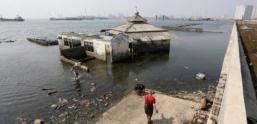The recent collapse of a seawall protecting the Indonesian capital of Jakarta has raised concerns about the ongoing flood threat.
When part of the seawall broke earlier this month, it brought back bad memories for Awing Takalar, a fisherman who lives nearby. He thought back to 2007, when another levee burst and washed all his belongings away.

Luckily, waves were not running high at the time of the most recent break. So, Takalar and others living in the area along Jakarta's northern shoreline were not flooded.
Takalar told the Reuters news agency that he knows he could be less lucky next time. My worry is that the water is higher than the land, the 46-year-old Takalar said. He expressed concern for the safety of his teenage daughter when she stays alone at the family's one-room home in Jakarta's Muara Baru area.
When the sea broke through the levee 12 years ago, Takalar took his family back to their home on the island of Sulawesi. When it got better, I returned again, he said. He added that once his daughter finishes school, he might leave the area for good.
Jarot Widyoko is the director of rivers and coasts at Indonesia's public works and public housing ministry. He said officials were investigating why a 170-meter stretch of the 2.3-kilometer-long wall broke -- even though it was built only a few years ago.
The incident has brought attention to efforts aimed at protecting parts of the low-lying city from major flooding in the future.
Jakarta has been slowly sinking. Large amounts of ground water have been extracted from under the city. Rising sea levels have made the threat of flooding even worse. The situation has pushed city officials to try to come up with protective measures.
In 2014, the government announced a plan to build a giant seawall along the coast as part of a $40-billion project to protect the city through 2030. The project includes a delayed plan to build a new city on a series of reclaimed islands in Jakarta Bay.












